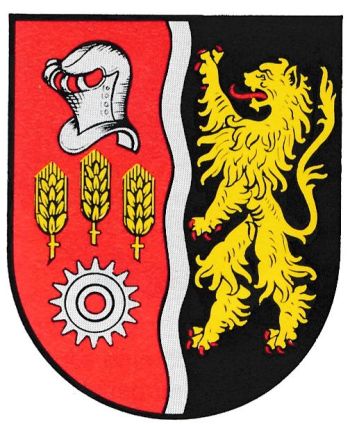Bechhofen (Pfalz): Difference between revisions
Jump to navigation
Jump to search
Knorrepoes (talk | contribs) m (Text replacement - "{{de}}" to "") |
Knorrepoes (talk | contribs) No edit summary |
||
| Line 1: | Line 1: | ||
{| class="wikitable" | |||
|- style="vertical-align:top;" | |||
|[[File:bechhofen.jpg|center|350 px|alt=Wappen von {{PAGENAME}}/Arms (crest) of {{PAGENAME}}]] | |||
| | |||
'''Country''' : Germany [[File:germany.jpg|60 px|right]]<br><br><br><br> | |||
'''State''' : [[Rheinland-Pfalz]][[File:rheinlan.jpg|60 px|right]]<br><br><br><br> | |||
'''District (Kreis)''' : [[Südwestpfalz]][[File:pirmasen.kreis.jpg|60 px|right]]<br><br><br><br> | |||
'''Verbandsgemeinde''': [[Verbandsgemeinde Zweibrücken-Land|Zweibrücken-Land]][[File:Zweibruc.amt.jpg|60 px]] | |||
{{#display_map:49.2632,10.7886|width=250|height=250|zoom=7}} | |||
|} | |||
{| class="wikitable" | {| class="wikitable" | ||
| Line 12: | Line 15: | ||
|- | |- | ||
|'''German''' | |'''German''' | ||
| | | Von Rot und Schwarz durch einen silbernen Wellenstab gespalten, rechts drei senkrecht stehende goldene Ähren, darüber ein silberner Spangenhelm, darunter ein silbernes Zahnrad, links ein rotbezungter und -bewehrter goldener Löwe. | ||
|- | |- | ||
|'''English''' | |'''English''' | ||
| | | Shield parted by a pallet wavy Argent, at dexter Gules three grain ears Or in fess between a helm Argent on chief and a cogwheel of the same on base, at sinister Sable a lion rampant Or armed and tongued Gules. | ||
|} | |} | ||
===Origin/meaning=== | ===Origin/meaning=== | ||
The arms were officially granted on June 2, 1986. | |||
The arms were officially granted | |||
The ears are symbole agriculture, the cogwheel industries. The helmet is alluding to the Knights of Bechhofen, who lived in the village around 1200. The lion is taken from the arms of the Dukes of Pfalz-Zweibrücken, former local rulers. The tinctures on dexter half are those of their predecessors, the Counts of Homburg. | |||
The village originally applied for arms in 1950 and the design showed a canting Pechofen (an oven to make wood-tar) and a helmet for the Knights of Bechhofen. | |||
[[Civic Heraldry Literature - Germany|'''Literature''']]: Debus, 1988 | |||
{{de1}} | {{de1}} | ||
| Line 33: | Line 36: | ||
[[Category:Rheinland-Pfalz]] | [[Category:Rheinland-Pfalz]] | ||
[[Category:Südwestpfalz]] | [[Category:Südwestpfalz]] | ||
[[Category:Granted | [[Category:Granted 1986]] | ||
Revision as of 05:07, 16 May 2023
|
Country : Germany State : Rheinland-Pfalz District (Kreis) : Südwestpfalz Verbandsgemeinde: Zweibrücken-Land |
| German | Von Rot und Schwarz durch einen silbernen Wellenstab gespalten, rechts drei senkrecht stehende goldene Ähren, darüber ein silberner Spangenhelm, darunter ein silbernes Zahnrad, links ein rotbezungter und -bewehrter goldener Löwe. |
| English | Shield parted by a pallet wavy Argent, at dexter Gules three grain ears Or in fess between a helm Argent on chief and a cogwheel of the same on base, at sinister Sable a lion rampant Or armed and tongued Gules. |
Origin/meaning
The arms were officially granted on June 2, 1986.
The ears are symbole agriculture, the cogwheel industries. The helmet is alluding to the Knights of Bechhofen, who lived in the village around 1200. The lion is taken from the arms of the Dukes of Pfalz-Zweibrücken, former local rulers. The tinctures on dexter half are those of their predecessors, the Counts of Homburg.
The village originally applied for arms in 1950 and the design showed a canting Pechofen (an oven to make wood-tar) and a helmet for the Knights of Bechhofen.
Literature: Debus, 1988




